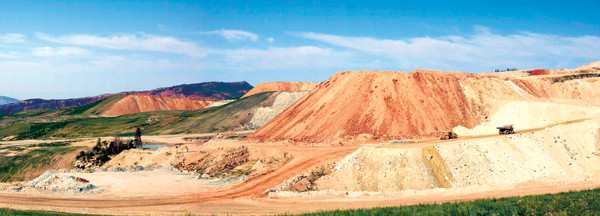
by U.S. Geological Survey Tuesday, June 19, 2018
Stephen M. Jasinski, mineral commodity specialist for the U.S. Geological Survey, has compiled the following information on phosphate rock, the source of phosphorus, one of the three essential plant nutrients.

A phosphate mine in Utah, one of four U.S. states to produce the mineral resource. Credit: ©Jason Parker-Burlingham, Creative Commons Attribution 2.0 Generic
As a mineral resource, “phosphate rock” is defined as unprocessed ore and processed concentrates that contain some form of apatite, a group of calcium phosphate minerals that is the primary source for phosphorus in phosphate fertilizers, which are vital to agriculture.
Phosphate rock deposits can be sedimentary or igneous, but more than 80 percent of the world’s current production of phosphate rock is mined from sedimentary deposits formed by deposition of phosphate-rich materials in marine environments. Large sedimentary deposits are located in China, the Middle East, northern Africa and the United States. Igneous deposits are associated with carbonatites and silica-deficient intrusions. These are mined in Brazil, Canada, Finland, Russia, South Africa and Zimbabwe. Phosphate rock is mined mostly by surface methods using draglines and bucket wheel excavators for large deposits and power shovels or earthmovers for smaller deposits. Underground mines use the room-and-pillar method, similar to coal mining. In 2013, phosphate rock was produced almost entirely from surface mines, with only one active underground mine in the world.
Phosphate rock, when used in an untreated form, is not very soluble and provides little available phosphorus to plants, except in some moist acidic soils. Treating phosphate rock with sulfuric acid produces phosphoric acid, the water-soluble material from which most phosphate fertilizers are derived.
Worldwide, more than 85 percent of the phosphate rock mined is used to manufacture phosphate fertilizers. The remaining 15 percent is used to make elemental phosphorus and animal feed supplements, or is applied directly to soils. Elemental phosphorus is used to manufacture a wide range of chemical compounds.
The first documented phosphate rock mining took place in England in 1847, using picks and shovels. Mining first began in the United States in 1867 in South Carolina. Phosphate rock was discovered in central Florida in the 1880s, and because of the extensive, high-quality deposits and lower mining cost, it quickly became the leading phosphate-producing state. Currently, phosphate rock is mined in Florida, Idaho, North Carolina and Utah. In the last half of the 20th century, Florida accounted for about 25 percent of total world phosphate rock production.
Nothing substitutes for phosphorus in agriculture. It is essential for plant nutrition and plays a vital role in photosynthesis, energy transfer, root formation, seed formation, plant growth and improvement of the quality of fruits and vegetables. Plants absorb large quantities of phosphorus from the soil, and annual applications of phosphate fertilizer are needed to maintain productivity of cropland.
Phosphorus is also an important nutrient for human and animal nutrition. It is necessary for the growth and repair of all body tissues and for the proper growth of bones and teeth, where about 85 percent of phosphorus in the human body is found. Phosphorus compounds are essential for energy production and storage in the body.
Visit http://minerals.usgs.gov/minerals for more information on phosphate rock and other mineral resources.
Phosphate rock production and consumption
U.S. production of phosphate rock in 2012 was 30.1 million metric tons, valued at $3.08 billion.
Total world production of phosphate rock in 2012 was 233 million metric tons. China was the leading producer, with 41 percent of world production, followed by the United States, Morocco and Western Sahara.
China, the United States, Morocco, Russia and India are the leading consumers of phosphate rock.
Morocco has 50 billion metric tons of phosphate rock reserves, which is about 75 percent of the world’s total.
Fun facts
Sedimentary phosphate rock deposits often contain fossilized remains of ancient fish and aquatic animals, such as manatees, sharks and whales.
Phosphate rock is used to make phosphate compounds, which are used in applications such as food additives, detergents and herbicides.
Phosphorus was first discovered in 1669 by Hennig Brand in Germany, when he recovered it from urine.
© 2008-2021. All rights reserved. Any copying, redistribution or retransmission of any of the contents of this service without the expressed written permission of the American Geosciences Institute is expressly prohibited. Click here for all copyright requests.